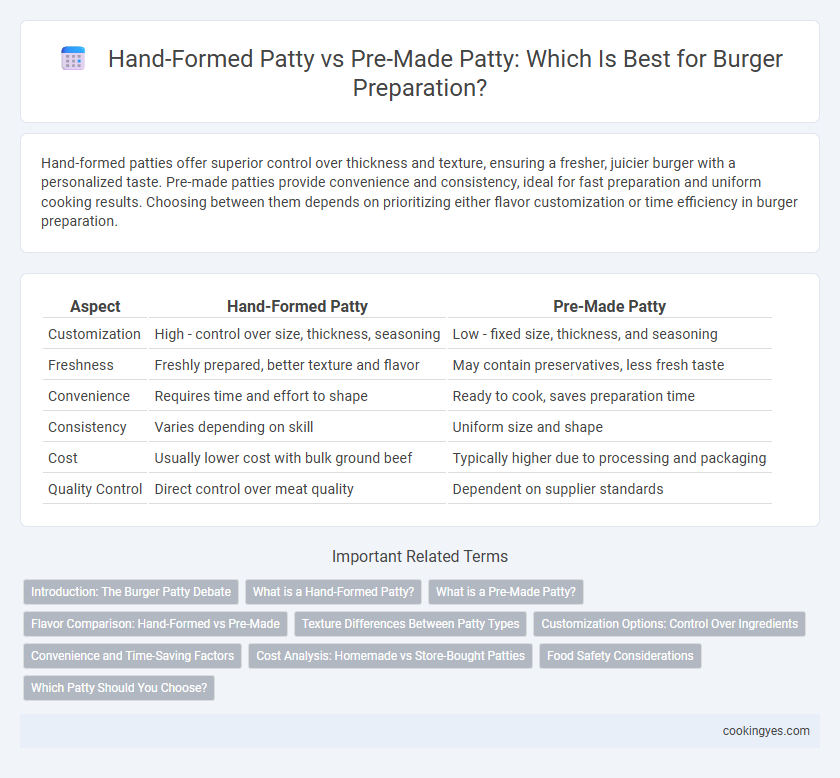Hand-formed patties offer superior control over thickness and texture, ensuring a fresher, juicier burger with a personalized taste. Pre-made patties provide convenience and consistency, ideal for fast preparation and uniform cooking results. Choosing between them depends on prioritizing either flavor customization or time efficiency in burger preparation.
Table of Comparison
| Aspect | Hand-Formed Patty | Pre-Made Patty |
|---|---|---|
| Customization | High - control over size, thickness, seasoning | Low - fixed size, thickness, and seasoning |
| Freshness | Freshly prepared, better texture and flavor | May contain preservatives, less fresh taste |
| Convenience | Requires time and effort to shape | Ready to cook, saves preparation time |
| Consistency | Varies depending on skill | Uniform size and shape |
| Cost | Usually lower cost with bulk ground beef | Typically higher due to processing and packaging |
| Quality Control | Direct control over meat quality | Dependent on supplier standards |
Introduction: The Burger Patty Debate
Hand-formed patties offer greater control over thickness, texture, and seasoning, resulting in a customized, juicy burger experience. Pre-made patties provide consistency and convenience, ideal for high-volume food preparation with standardized cooking times. Understanding the differences in flavor, moisture retention, and cooking adaptability helps in selecting the best patty type for desired burger quality.
What is a Hand-Formed Patty?
A hand-formed patty is crafted by shaping ground meat manually, allowing for customization in size, thickness, and seasoning to achieve a unique flavor profile. This technique enhances texture and juiciness by preserving the meat's integrity, unlike pre-made patties that are machine-pressed and often uniform. The artisanal approach supports better control over quality, ensuring each burger offers a distinct, freshly made experience.
What is a Pre-Made Patty?
A pre-made patty is a commercially produced, uniformly shaped burger patty that is typically mass-manufactured and frozen for convenience and consistency. These patties are often made from ground beef, blended with seasonings and additives to maintain texture and flavor during storage and cooking. Pre-made patties provide a standardized size and weight, ensuring faster cooking times and simplified portion control in both home kitchens and food service operations.
Flavor Comparison: Hand-Formed vs Pre-Made
Hand-formed patties offer superior flavor due to the ability to customize seasoning and maintain fresh, high-quality meat, enhancing juiciness and texture. Pre-made patties often contain preservatives and uniform seasoning, resulting in a more consistent but less complex taste profile. Flavor intensity and depth are generally higher in hand-formed patties, appealing to gourmet burger enthusiasts.
Texture Differences Between Patty Types
Hand-formed burger patties offer a coarser, more varied texture due to uneven compression, creating pockets of juicy fat that enhance mouthfeel. Pre-made patties are uniformly pressed, resulting in a denser, more consistent texture but often lack the same juiciness and character. The choice impacts the overall eating experience, with hand-formed patties delivering a more artisanal and satisfying bite.
Customization Options: Control Over Ingredients
Hand-formed burger patties offer superior control over ingredients, allowing customization of meat blends, fat content, and seasoning to suit dietary preferences or flavor profiles. This method ensures freshness and the ability to exclude additives or preservatives commonly found in pre-made patties. In contrast, pre-made patties provide convenience but often lack the flexibility to tailor ingredients for specific nutritional or taste requirements.
Convenience and Time-Saving Factors
Hand-formed patties offer customization and freshness but require more time and effort for shaping and portioning. Pre-made patties provide significant convenience by reducing prep time and ensuring consistent size, ideal for fast-paced kitchen environments. Choosing pre-made patties enhances efficiency during busy service hours without compromising basic quality standards.
Cost Analysis: Homemade vs Store-Bought Patties
Hand-formed patties typically incur higher labor costs due to the time-intensive preparation process but offer better control over ingredient quality and portion size. Store-bought patties reduce labor expenses and provide consistent weight and shape, often translating to lower overall cost per unit when purchased in bulk. Balancing the cost of raw ingredients, labor, and consistency determines the most economical choice for burger preparation in commercial and home settings.
Food Safety Considerations
Hand-formed patties allow for better control over meat quality and thickness, reducing the risk of uneven cooking and potential bacterial contamination. Pre-made patties are often produced under strict industrial hygiene standards, yet can pose risks if frozen and thawed improperly, leading to pathogen growth. Ensuring proper cooking temperature, typically 160degF (71degC) for ground beef, is critical in both methods to guarantee food safety and prevent foodborne illnesses.
Which Patty Should You Choose?
Hand-formed patties offer a fresher, juicier texture with customizable seasoning and thickness, enhancing flavor and cooking control. Pre-made patties provide convenience, consistent size, and quick preparation, ideal for busy kitchens or meal prepping. Choosing between hand-formed and pre-made patties depends on your priorities for taste, time, and cooking precision in burger preparation.
Hand-Formed Patty vs Pre-Made Patty for Burger Preparation Infographic

 cookingyes.com
cookingyes.com